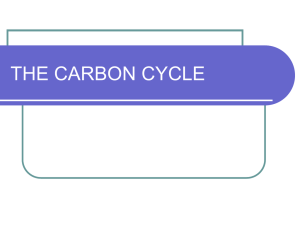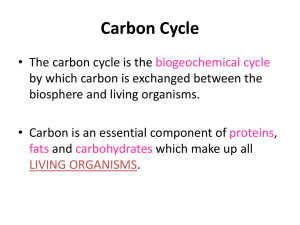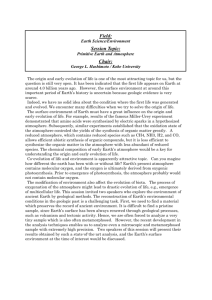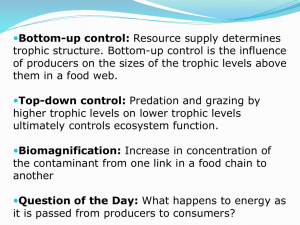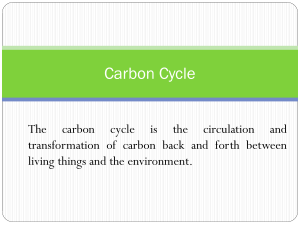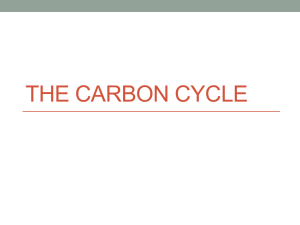Carbon Balance DQC_diganosis
advertisement
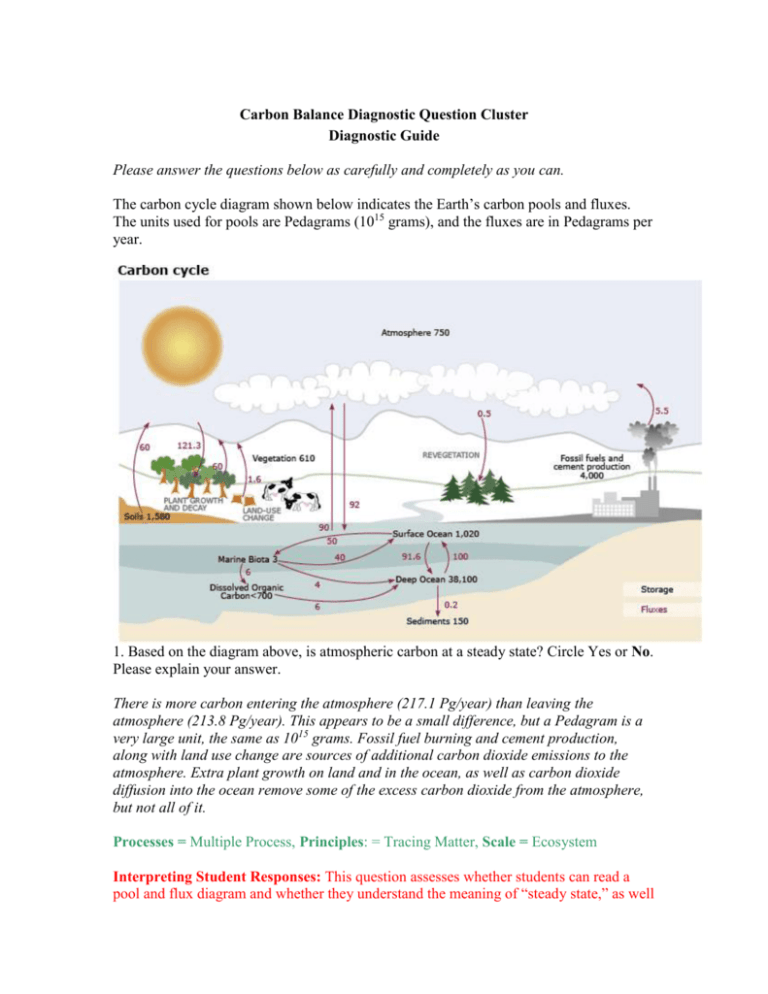
Carbon Balance Diagnostic Question Cluster Diagnostic Guide Please answer the questions below as carefully and completely as you can. The carbon cycle diagram shown below indicates the Earth’s carbon pools and fluxes. The units used for pools are Pedagrams (1015 grams), and the fluxes are in Pedagrams per year. 1. Based on the diagram above, is atmospheric carbon at a steady state? Circle Yes or No. Please explain your answer. There is more carbon entering the atmosphere (217.1 Pg/year) than leaving the atmosphere (213.8 Pg/year). This appears to be a small difference, but a Pedagram is a very large unit, the same as 1015 grams. Fossil fuel burning and cement production, along with land use change are sources of additional carbon dioxide emissions to the atmosphere. Extra plant growth on land and in the ocean, as well as carbon dioxide diffusion into the ocean remove some of the excess carbon dioxide from the atmosphere, but not all of it. Processes = Multiple Process, Principles: = Tracing Matter, Scale = Ecosystem Interpreting Student Responses: This question assesses whether students can read a pool and flux diagram and whether they understand the meaning of “steady state,” as well as explaining the current imbalance in the global carbon cycle due to human activities. Students often struggle to interpret carbon cycle diagrams, limiting their understanding of the processes involved in carbon fluxes and pools. Students misinterpreting this diagram can be further diagnosed using the single process questions below. Example Student Answers: Yes = 8/18, No = 10/18 Yes “213.8 v 217.1 - Almost same number exiting and entering.” “There is an equal amount of carbon that is being absorbed by the "sinks" and an equal amount given off by the "sources.” No: “I do not think it is at a steady state. There is more carbon going into the atmosphere than there is coming out. So atmospheric carbon is increasing.” “because there is carbon both leaving and entering the atmosphere.” 2. Scientists believe that the average temperature of the earth’s atmosphere has been increasing during the past 100 years. What is the major cause of this? A) More heat is released from vehicles and factories into the atmosphere. B) More particulate pollution (smog) is in the atmosphere. C) More carbon dioxide is in the atmosphere. D) Deterioration of the ozone layer E) None of these causes global warming. Please explain your answer. Carbon dioxide is a greenhouse gas, which traps heat in the Earth’s atmosphere by absorbing specific infrared wavelengths that would otherwise continue to pass through the atmosphere, back into space. Human activities have substantially increased the amount of carbon dioxide in the atmosphere, which has caused a significant increase in average Earth surface temperatures. Processes = Greenhouse Effect, Principles = Tracing Matter and Energy, Scale = Ecosystem Interpreting Student Responses: Students must understand the process by which climate change is occurring, as biofuel combustion results in carbon dioxide released to the atmosphere, which traps heat near the Earth’s surface. Many students attribute climate change to the depletion of the ozone layer. All responses are chosen by students at varying frequencies. Example Student Answers: A=2/25, B=6/25, C=20/25, D= Not Included in Draft, E=3/25 (some students circled more than one answer). B: “Pollution is releasing toxins into our atmosphere that is slowly but more increasingly breaking the atmosphere barrier down. This is allowing greenhouse gases to be released making the temperature to increase.” C: “Carbon dioxide is a greenhouse gas and helps keep heat inside the atmosphere.” E: “Global warming has a lot to do with chemical that we let out from human things. A,B,C are all under the global warming.” B&C: “B leads to C and an overall higher temperature because of the greenhouse effect.” 3. Draw arrows to explain how food moves through a green plant. Explain what the plant’s food is, and where it comes from. Arrows should point downward, from the leaves down to the stem and/or roots. The plant’s food is glucose that is created in the leaves through the process of photosynthesis. The glucose is made from carbon dioxide from the atmosphere and water from the soil, both of which meet in the leaves for the process. Processes = Photosynthesis, Transformation, Principles = Tracing Matter, Scale = Organismal Interpreting Student Responses: In order to answer this question, students need to understand what food is, where it is created, and that food moves from where it is created to where it is used. Students may provide answers that show they do not understand what food is and that photosynthesis is the process that creates food. Sample Student Answers: Food moves from soil up = 9/25, Food moves from leaves down = 9/25, arrows go both ways = 7/25 “”Food” is created in green (chlorophyll) containing areas of the plant and stored in the roots”. “Food moves upwards towards the leaves to make photosynthesis happen”. This student does not understand what food is and that photosynthesis is the process that creates food. 4. Coal, oil, and gas are called fossil fuels. What were they before they became fossil fuels? Before becoming fossil fuels, these substances were living plants millions of years ago. These plants died and were protected from decomposition by various factors, Instead of being decomposed, the dead plants were compressed within the Earth and the process converted them into the fossil fuels we have today. Processes = Photosynthesis, Transformation, Principles = Tracing Matter, Scale = Ecosystem Interpreting Student Responses: This question assesses whether students understand the remains of ancient plants are the source of fossil fuel, and that those plants obtained their carbon from carbon dioxide in the atmosphere. Students often think that prehistoric animals and plants were “decomposed” into fossil fuels, which shows that they have troubles tracing matter through time, as decomposition would cause the carbon atoms to be released to the atmosphere. Example Student Answers: “Natural resources” “Separate elements” “Organic matter that eventually decomposes into fossil fuels” “I think there are fossil fuels to start with I think gas can come naturally and oil is natural as well” “Old plants, trees, swamps, organic material” 5a. In the fall, the leaves on trees in a deciduous forest fall to the ground. Explain what happens to the leaves once they fall to the ground. The leaves are decomposed by soil organisms. The matter in the leaves is lost as carbon dioxide and water as the decomposers break down the organic substances in the leaves. 5b. Do the changes in the dead leaves affect atmospheric carbon dioxide levels? Circle Yes or No. Why or why not? Plants absorb carbon dioxide from the atmosphere during photosynthesis, thus removing carbon dioxide from the atmosphere. Decomposers that break down the leaves release carbon dioxide to the atmosphere, thus increasing carbon dioxide levels back to where they were before the plant produced the leaves. Processes = Respiration, Transformation, Principles = Tracing Matter, Scale = Organismal Interpreting Student Responses: Part A of the question assesses whether students understand that decomposers use discarded plant tissue as a source of carbon and energy. Part B assesses whether students see a link between decomposition and atmospheric carbon dioxide. A matter-tracing answer to Part A would follow the carbon, hydrogen, oxygen, and other elements into CO2, H2O, and soil minerals. Part B would then be redundant. Note, though, how different the students’ answers to Parts a and b tend to be. Part a responses mention the leaves going into the soil or energy, but not CO2. Part B responses that mention decomposition releasing CO2 still often fail to mention the origins of the carbon. Most students think that leaves will decompose. Some students have difficulty seeing a link between decomposition of the dead leaves in the soil and atmospheric gasses, specifically CO2. Example Student Answers: Part a: “They decompose and/or get eaten by bugs.” “The carbon cycle absorbs the leaves into the soil.” “They are broken down into organic matter in the soil.” “The leaves decompose and give energy to the soil to help with the growth of new life.” Part b: Yes = 20/22, No = 2/22 Yes: “As they decompose the release elements into the air” “Decomposers add CO2 to the atmosphere” “because they are not absorbing the CO2 causing the level to rise” No: “Currently they have no effect, however their ancestors from long ago are contributing to the rise in CO2 levels as they are burned as fossil fuels” “because all of the carbon in leaves enters soil and then atmosphere” 6. Power plants often burn coal to produce electricity. Where do the atoms in the coal go when it is burned? Decide whether each of the statements below is true (T) or false (F). T T T T T F F F F F Some of the mass of the coal produces carbon dioxide in the atmosphere. Some of the mass of the coal produces sulfuric acid in the atmosphere. Some of the mass of the coal is converted to heat and electrical energy. Some of the mass of the coal produces oxygen in the atmosphere. Some of the mass of the coal is consumed by the flame when it is burned. Processes = Combustion, Principles = Tracing Matter, Scale = Atomic-Molecular Interpreting Student Responses: This question assesses whether students know that coal is made of carbon atoms and that during combustion, the molecules within coal are rearranged to form different molecules. Students may have difficulty tracing matter during its conversion from one form to another (“produces sulfuric acid”), may not trace matter at all (“consumed by the flame”), or may think that matter can be converted to energy (“coal is converted into heat energy”) Example Student Answers: 27/27 True, 0/27 False, 0/27 Not Sure 13/27 True, 7/27 False, 7/27 Not Sure 25/27 True, 1/27 False, 1/27 Not Sure 4/27 True, 17/27 False, 6/27 Not Sure 12/27 True, 12/27 False, 3/27 Not Sure


